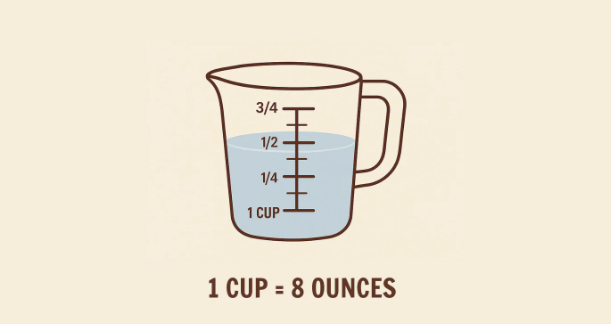How Many Ounces Are in a Cup? Simple Guide for Everyday Cooking

How many ounces are in a cup is one of the most common cooking and baking questions. If you are in the kitchen making cookies, soup, or a smoothie, you will often need to measure ingredients. Sometimes recipes use cups, and other times they use ounces. This can feel confusing, especially if you are new to cooking or baking. Knowing the answer can save you time, help you avoid mistakes, and make your food taste just right. Whether you are using dry ingredients like flour or wet ingredients like milk, understanding this simple conversion can make your kitchen life much easier.
How many ounces are in a cup depends on what you are measuring. Liquid ounces and dry ounces are not always the same. For example, one cup of water equals 8 liquid ounces, but one cup of flour weighs less in dry ounces. This is because liquids fill the cup evenly, while dry ingredients can be packed or loose. Learning this difference can help you follow recipes more accurately and improve your cooking skills. Once you know the basic measurement rules, you will be able to switch between cups and ounces without worry, making your recipes come out perfect every time.
Table of Contents
What Does a Cup Mean in Cooking Measurements
A cup in cooking is a standard measuring unit used in many recipes. In the United States, one cup equals 8 fluid ounces for liquids. But remember, a cup is about volume, not weight. This means it tells you how much space something takes up, not how heavy it is.
In other countries, a cup might mean a slightly different size. For example:
- In the UK, a cup is about 10 fluid ounces.
- In Australia, a cup equals 8.45 fluid ounces.
If you use recipes from around the world, it’s good to check which type of cup they mean.
How Many Ounces Are in a Cup for Liquids
For liquids like water, milk, juice, or oil, 1 US cup = 8 fluid ounces. This is the easiest measurement to remember. When a recipe says “1 cup milk,” you can pour it into a measuring cup until it reaches the 1-cup line, which is 8 fluid ounces.
Example:
- ½ cup water = 4 fluid ounces
- ¼ cup water = 2 fluid ounces
It’s that simple for liquids.
How Many Ounces Are in a Cup for Dry Ingredients
Dry ingredients are a little tricky. A cup of flour does not weigh the same as a cup of sugar because they have different densities. That’s why dry ounces (weight) and fluid ounces (volume) are not always equal.
Examples:
- 1 cup all-purpose flour ≈ 4.5 ounces (dry weight)
- 1 cup granulated sugar ≈ 7 ounces (dry weight)
The easiest way to be accurate is to use a kitchen scale for dry ingredients. This avoids mistakes and gives you the best results in baking.
The Difference Between Liquid Ounces and Dry Ounces
Liquid ounces measure volume, while dry ounces measure weight. You cannot swap them directly. For example, 8 fluid ounces of water is not the same weight as 8 ounces of flour.
Think of it like this:
- Fluid ounces → how much space a liquid takes up.
- Dry ounces → how heavy an ingredient is.
This is why baking recipes often give weight in ounces or grams for better accuracy.
How to Measure Ingredients Correctly in the Kitchen
Measuring correctly can make or break your recipe. Here’s how:
- For liquids: Use a liquid measuring cup with a spout and fill to the correct line.
- For dry items: Use dry measuring cups, scoop the ingredient, and level it with a flat edge.
Pro tip: Never shake or press dry ingredients unless the recipe says so. Pressing flour into a cup can make you use more than needed.
Why Cups and Ounces Can Be Confusing
The confusion comes because “ounce” is used for both weight and volume. Many beginners think they are the same, but they are not. This mix-up can ruin recipes, especially in baking where precision matters.
Also, recipes from different countries use different standards. That’s why having a conversion chart or kitchen scale is very helpful.
Conclusion
Knowing how many ounces are in a cup can save you from kitchen disasters. Remember that liquid ounces measure volume, and dry ounces measure weight. For liquids, 1 cup = 8 fluid ounces. For dry ingredients, the weight in ounces changes depending on what you’re measuring. Using the right tools and understanding the difference will make your cooking and baking much easier.
FAQs
Q1: Is 1 cup always equal to 8 ounces?
No, only for liquids in the US system. Dry ingredients vary in weight.
Q2: Can I use the same cup for liquids and dry ingredients?
You can, but it’s better to use the right type of measuring cup for accuracy.
Q3: How many ounces are in a UK cup?
A UK cup is about 10 fluid ounces, which is slightly bigger than a US cup.
Q4: What’s the easiest way to measure dry ounces?
Use a kitchen scale for best results.
Q5: Why do recipes use cups instead of ounces?
Cups are easier for many home cooks, but ounces are more accurate.



